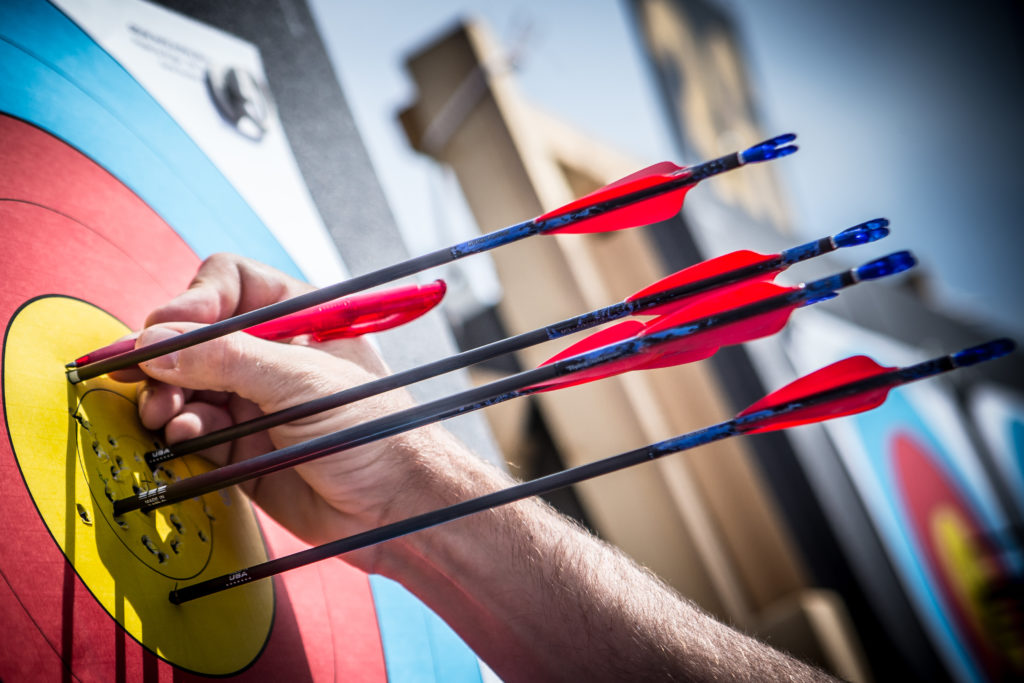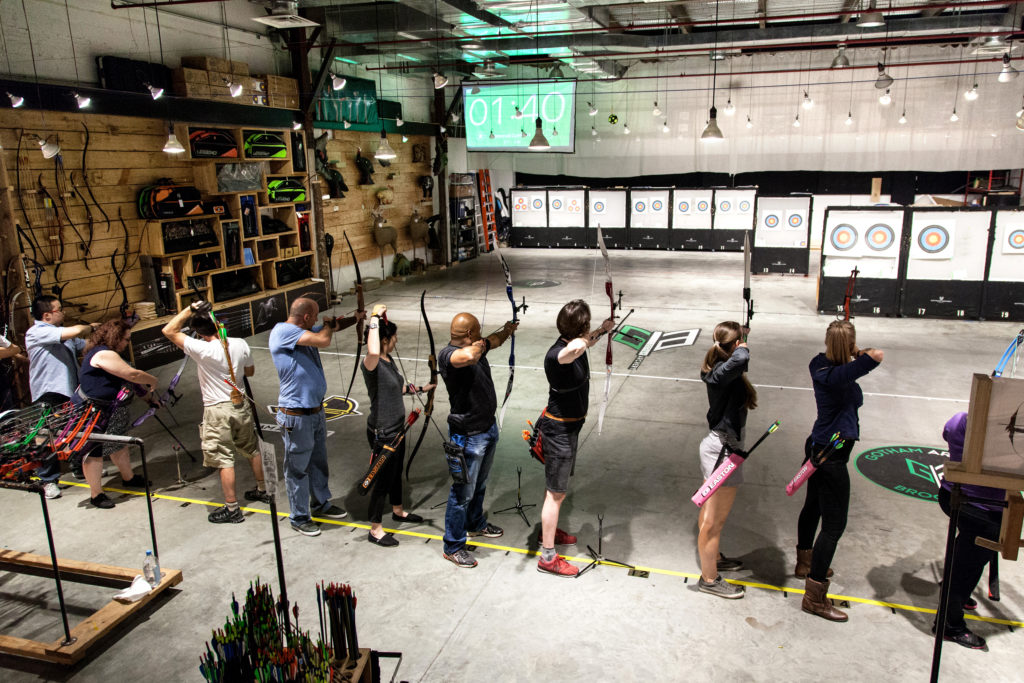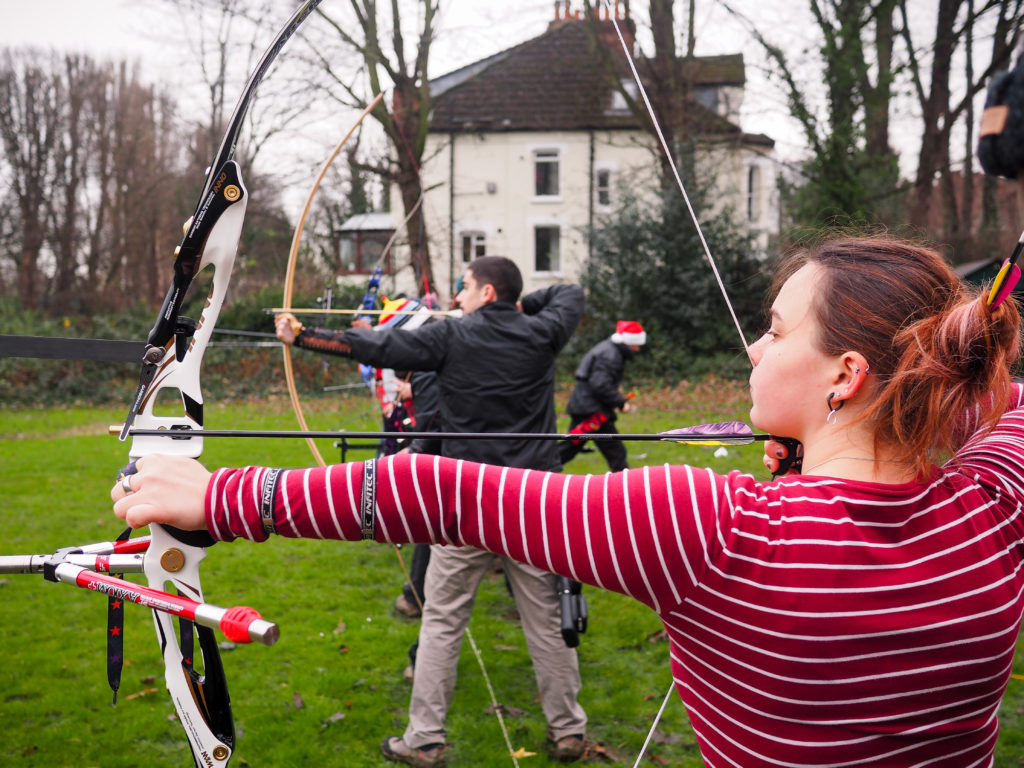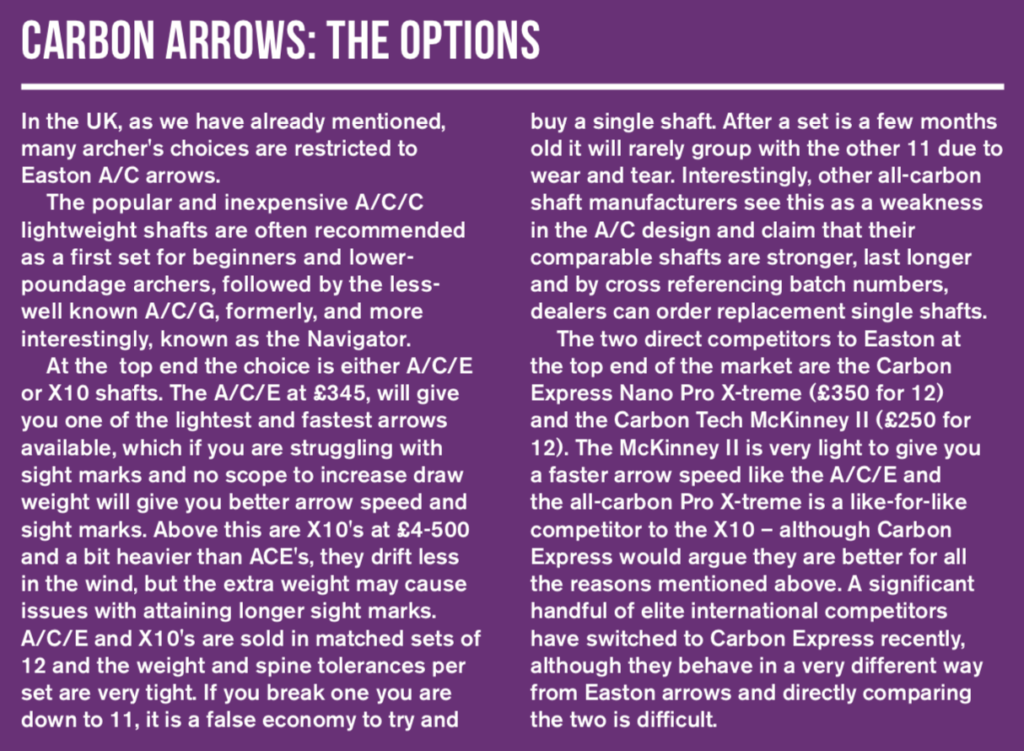When it comes to selecting carbons, it’s still best to approach things carefully. By Andrew Smith

Competitive archers are always looking for an advantage and constantly musing over how they can improve their equipment. Arrows are always high on the list with questions like: “can my choice of shaft buy me points, will one set of arrows be better than another, is one manufacturer the go to brand and how do I ensure that they are the right spine for me?” After all, you do not want to spend all those hours training to be let down by a crucial piece of equipment.
Arrows are the most important piece of equipment that you need to spend time getting right (after you have sorted out your draw weight). Choosing the wrong specification might end up being an expensive mistake and will probably reduce your scores.
Here I will look at all these questions and concerns to help you decide on the correct shaft. To keep it simple, we will concentrate solely on the shaft choice, not all the other items that make up an arrow.
It cannot have escaped anyone’s notice that for 22 years the most popular arrow shafts used by top internationals is the Easton X10. For competitive archers, is this still the go-to shaft, or are there other alternatives?
Two types of shaft
‘Carbon shaft’ is a catchall phrase to cover all carbon-constructed used today. Carbon arrow shafts come in two distinct flavours – ‘all-carbon’, made up of carbon and resin tubes, and shafts with carbon wrapped around the outside of a thin aluminium tube, usually called A/C shafts. Whilst there are now many companies that produce ‘all-carbon’ shafts, there is only one that produces A/C shafts: Easton Archery.
Using carbon arrows in the UK
Before we start to consider the options, there is a unique situation briefly mentioned above relating to the UK, that needs to be addressed. Most clubs in the UK shoot on multipurpose playing fields and usually somewhere in the small print of the terms of hire is a statement “all arrows must be found by the end of the shooting session.”
Consequently, many clubs in this position have banned the use of all-carbon shafts, mainly on the grounds that they are harder to find with a metal detector.
However, regardless of local idiosyncrasies, all-carbon shafts cannot be banned at World Archery world record status (WRS) shoots, as it would make a nonsense of WRS status if legal equipment that can be used all over the world is excluded in the UK.
The minefield of spine selection
Regardless of the arrow shaft you choose – all-carbon or A/C, the most important selection criteria is to get the correct spine – the right bendiness to travel around the bow without hitting the rest, button or riser and then to fly straight to the target.

This is a cause of much frustration to many archers as selecting the correct spined shaft is complicated. Most archers will turn to the manufacturer’s selection chart, put in the relevant information and like magic the chart will suggest a suitably spined shaft.
Unfortunately, as many archers have found out, when it comes to carbon shafts it is not as simple as that. Some manufacturers spend a lot of time trying to get the charts more accurate, but there are just too many variables to take into consideration.
Everything about how you shoot and the equipment you are using influences the correct spine selection. Even two archers with identical equipment and draw lengths may require differently spined shafts.
Factors like bow efficiency, the design and characteristics of your limbs, string material, tab face, even how good your form is will affect the speed and bend induced on the arrow and influences the final choice.
It is also important to mention that shaft spine numbers are not easily cross-referenced from manufacturer to manufacturer, there can be differences beyond just the spine.
Some shafts are made parallel, the same diameter along the shaft, others barrelled, for aerodynamic advantage where the ends are thinner than the middle. Parallel shafts tend to behave stiffer for the same spine rating than barrelled shafts.
So, if the charts are at best 50% accurate how do you select the correctly spined shafts?
A method of selecting the right spine
The only completely reliable way to select the spine is to shoot all the arrow shaft options that may be the correct spine. From the test results you will find the one shaft that will tune the best.
Firstly, it is important that your bow is set up correctly, especially that the limb tips are straight and the nocking point and centreshot are good, you must be shooting well and not planning to change your draw weight too soon, even 2-3lb will make a big difference to the final selection.
Using the charts as a starting point (remembering to read the small print about arrow length), you can narrow down the choice to probably three spines. Higher quality shafts tend to have spine ratings that are closer together and are more accurate.

It is then the case of shooting these shafts as fletched arrows (using the recommended point weight for the spine of the shaft) and ‘balanced’ bareshafts, to find the same spined bareshaft and arrow that land closest to each other. You may be reading this thinking: “I don’t have the time or money to do this.”
Unfortunately, there is no substitute for experience when selecting carbon shafts. For those that do not have the time, equipment or the confidence in getting it right there are a couple of archery dealers in the UK that for a small fee offer a carbon arrow selection service.
Initially all shooting can be done at 18m, once the shaft spine has been selected and the arrows made up, all that should be needed is fine tuning of the button, nocking point and possibly a small adjustment to draw weight to get even tighter groups, which most do at 70m. However, before fletching I always suggest nock tuning to ensure that all the unfletched shafts group together and there is not a rogue shaft.
With the right experience you can shoot another model of shaft from the same manufacturer with the same/similar spine rating and cross-reference the results. This is particularly useful when buying say Easton X10’s sold in sets of 12, to keep costs down you can use Easton ACC shafts to work out the best result.
Is expensive the best option
A question I get asked a lot is: will I see the benefit shooting the most expensive set of arrows? This somewhat depends on how good the archer is. You cannot buy points in archery.
Some of the top of the range shafts are also quite sensitive and require good form (specifically, the release) to consistently fly straight, and some archers may find that scores will be no different or could even be worse than their current set – in the same way that most of us would get a better lap time around Silverstone in a Ford Fiesta than the latest Formula One car.
Shaft choice overload
We probably now have too much choice when it comes to all-carbon shafts. In the past five years the number of companies making all-carbon arrows has exploded.
The more established brands – Carbon Express, Carbon Tec, Gold Tip and Victory are now joined by Fivics, Avalon, Skylon and hundreds more unnamed shafts manufactured in China. But beware of the tempting low cost, as many of these shafts are not suitable for target archery, as they are manufactured for the hunting and compound communities.
Your archery form is critical
Shaft choice is all about getting the correct spine, if you have no restrictions on the type of arrow you can shoot, then the top of the range target all-carbon shafts from the established manufacturers are a viable alternative to the market leader and the differences in your groups will be hard to differentiate.
You cannot buy points just by going for the most expensive arrow shafts, but the better you shoot, the easier it is to select the right manufacturer and shaft for you. In the end, for serious archers the choice will be more about your budget and what is going on in your head, as we all know that arrows we believe in will always group better.
Your final selection is not something that an anonymous forum answer, YouTube video or marketing blurb can help with. If unsure, you really need to find a trusted knowledgeable person/archery dealer to help you select the correct spine to put your mind at rest, allowing you to concentrate on improving your form. Or do what it seems most do when selecting a shaft, and just follow everyone else.


